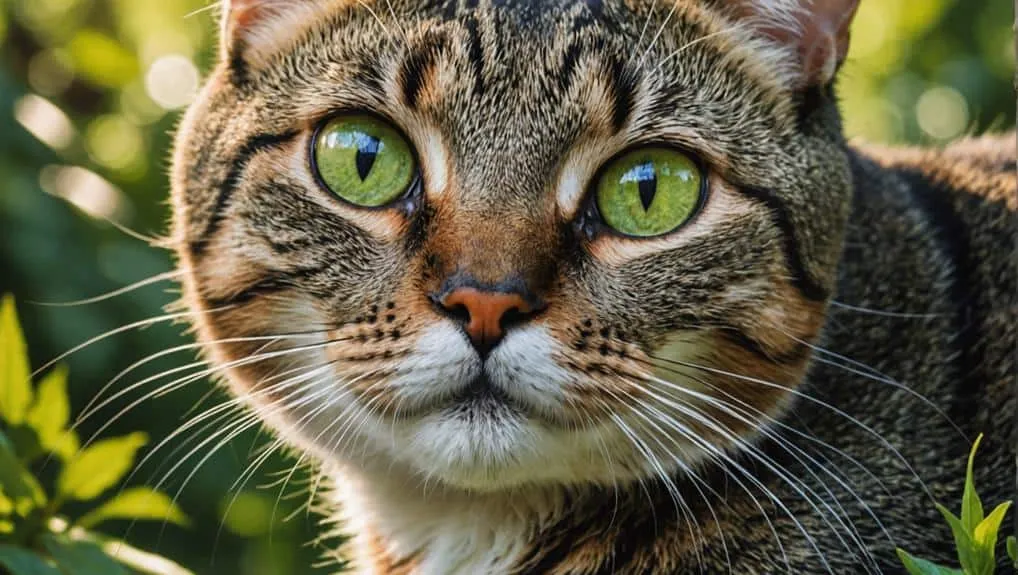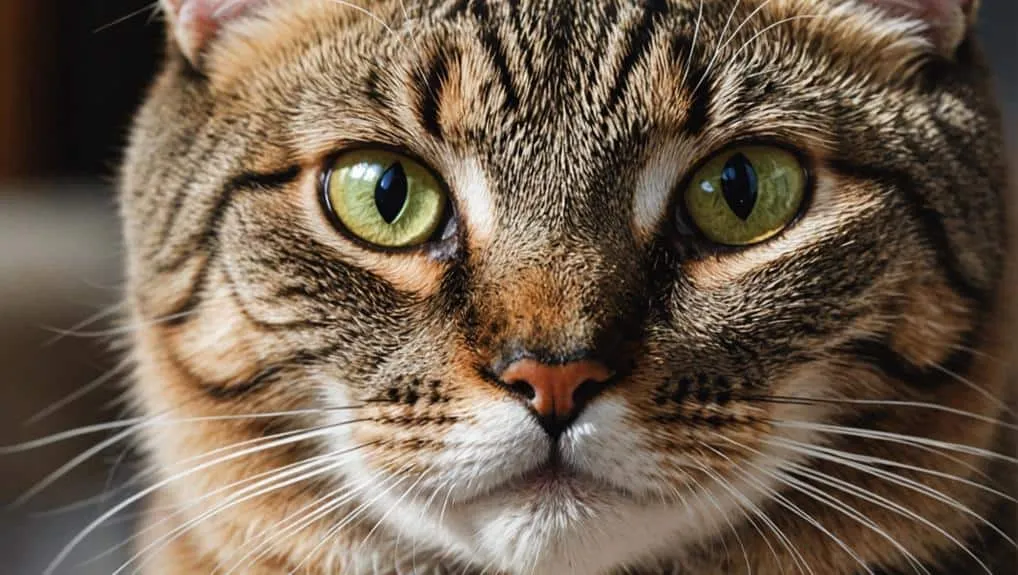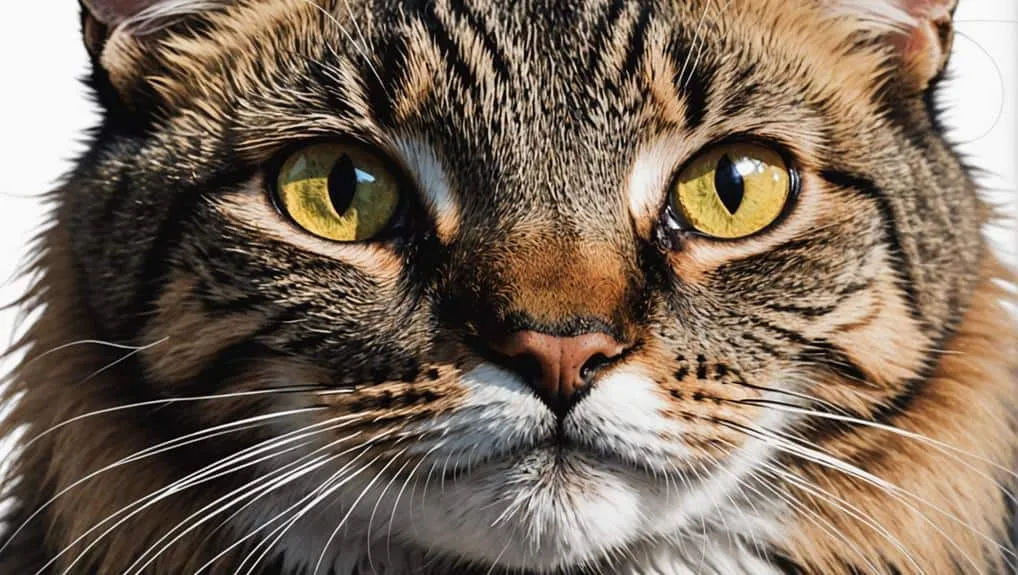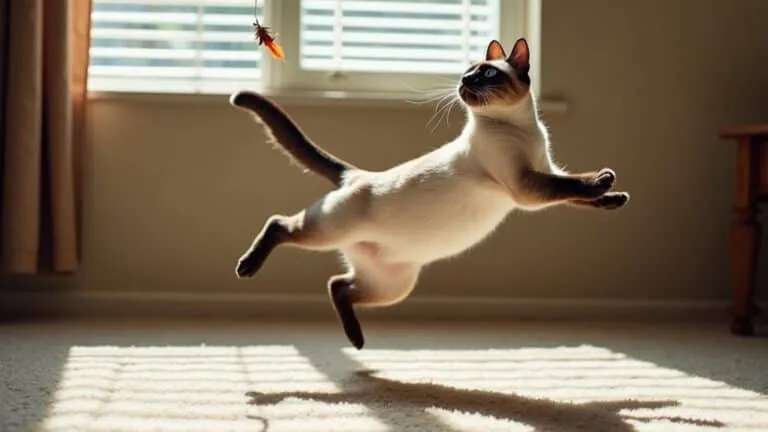The Best Fluffy Pancakes recipe you will fall in love with. Full of tips and tricks to help you make the best pancakes.

Cats rely on their whiskers for essential sensory input that helps them navigate their environment. These specialized hairs gauge distances, allowing you to assess whether you can fit through tight spaces. Whiskers are packed with nerve endings, enhancing your cat’s spatial awareness and detecting air currents and vibrations. They also serve as emotional indicators, with their positions signaling curiosity or discomfort. Additionally, whiskers enhance a cat’s night vision and hunting abilities. Understanding your cat’s whiskers can enrich your knowledge of their behavior and needs, offering deeper insight into their unique sensory world.

Whisker Structure and Anatomy
Whiskers, or vibrissae, play an essential role in a cat’s sensory perception. Understanding their structure and anatomy is significant for appreciating how these specialized hairs function.
Cats typically have 24 whiskers on their face, arranged in four distinct rows, with 12 on each cheek. This arrangement allows for balanced sensory input, enhancing their awareness of their surroundings.
Embedded deep within the skin, whiskers emerge from hair follicles positioned three times deeper than regular fur. This depth contributes to their heightened sensitivity. Whiskers are generally coarser and thicker than standard hair, measuring about twice the width of a cat’s body, which assists in spatial perception.
In addition to facial whiskers, cats possess additional vibrissae above their eyes, on their chin, and on their forelegs, further enriching their sensory capabilities.
As cats age, you might notice whiskers changing color from white to grey or black. However, this change doesn’t compromise their functionality in sensory processing.
Sensory Functions of Whiskers
Cats rely on their whiskers as essential sensory tools that enhance their ability to navigate the world around them. These specialized structures, known as vibrissae, are packed with nerve endings that allow them to transmit important sensory input. When a cat moves through its environment, its whiskers detect subtle air currents and vibrations, providing a heightened sense of touch that helps assess nearby objects.
Each whisker is strategically embedded in the skin, enabling cats to gauge the size and shape of items within their vicinity. This built-in measuring tool serves a practical function; the length of the whiskers is generally about twice the width of the cat’s body, allowing them to determine whether they can fit through narrow spaces.
Moreover, whiskers enhance a cat’s night vision and navigation abilities, making them indispensable for exploration and hunting, particularly in low-light conditions. The proprioceptors at the base of whiskers relay significant information about body positioning, contributing to a cat’s spatial awareness.
Therefore, whiskers aren’t merely decorative; they play a critical role in helping cats successfully navigate their environment.
Role in Balance and Movement

How do cats manage to maintain such remarkable balance and agility? One key factor lies in their whiskers, which contain proprioceptors at their base. These specialized sensory receptors provide critical information about the cat’s body position and orientation relative to the ground. This feedback is essential for maintaining equilibrium, especially when maneuvering through complex environments.
Whiskers greatly enhance a cat’s spatial awareness, allowing for precise navigation through tight spaces. Their sensitivity to air currents and vibrations helps detect nearby obstacles, which is crucial for agile movement during hunting or play. This capability is particularly important in low-light conditions, where whiskers serve as an extension of the cat’s sensory perception.
Moreover, the proprioceptors in the whiskers contribute to the cat’s ability to land on their feet when falling, demonstrating their role in balance.
As you observe a cat move gracefully, remember that its whiskers aren’t just decorative; they’re intricate tools that inform and enhance balance and movement.
Communication and Emotional Indicators
In the domain of feline communication, whiskers serve as essential indicators of a cat’s emotional state and intentions. The positioning of these sensitive hairs can reveal a great deal about how your cat feels in any given moment.
For instance, elevated whiskers often signal curiosity or happiness, while taut whiskers suggest discomfort or a perception of threat. Whiskers function as non-verbal communication tools, conveying a cat’s mood and reactions to both its environment and other animals.
When whiskers are relaxed, it typically indicates a state of calmness and contentment. In contrast, pushed-back whiskers may denote anxiety or defensiveness, signaling that your cat feels threatened.
Forward-extended whiskers indicate alertness and interest, suggesting your cat is attentive to its surroundings or potential prey.
Care and Protection of Whiskers

Maintaining the health and integrity of a cat’s whiskers is essential for their overall well-being. Whiskers function as essential sensory organs that help cats navigate their environment. Since whiskers are approximately three times deeper than regular cat hair, they’re highly sensitive to changes around them.
Gentle handling is critical; pulling or cutting whiskers can disorient cats due to their strong connection to the feline brain.
To promote whisker health, consider the feeding setup. Using flat food and water dishes minimizes whisker fatigue and discomfort, reducing excessive contact during meal times. This consideration can help prevent overwhelming sensory input that might lead to stress.
Regularly monitoring whisker health is also important. If a whisker falls out, it typically regrows within 6 weeks to 3 months, provided the follicles remain unharmed.
Purpose of Whiskers
Cats’ whiskers are more than just facial features; they act as crucial sensory navigation tools that enhance your cat’s awareness of their surroundings.
These whiskers also serve as indicators of your cat’s emotional state, helping you understand their mood.
Sensory Navigation Tool
Whiskers serve as essential sensory navigation tools for felines, enabling them to interact effectively with their environment.
These specialized sensory organs, known as vibrissae, allow cats to detect subtle air currents and nearby objects, markedly enhancing their ability to navigate different surroundings. With an average of 24 whiskers, positioned strategically on each cheek, cats gain balanced measurements critical for spatial awareness and movement assessment.
Whiskers can sense vibrations and shifts in airflow, which aids in gauging distances and avoiding obstacles, particularly in low-light conditions. This remarkable sensitivity is vital for both everyday exploration and hunting activities.
The thicker structure of whiskers, deeply rooted in the skin, acts like a built-in measuring device, empowering cats to navigate through tight spaces with agility and precision.
During a hunt, whiskers play a key role by helping cats evaluate the proximity of prey. This sensory feedback allows for accurate leaps and movements, ensuring they can make the most of their hunting prowess.
Emotional Expression Indicators
The positioning of whiskers can reveal essential insights into a cat’s emotional state. When whiskers are relaxed, it generally indicates that the cat feels calm and content. In contrast, forward-facing whiskers suggest curiosity or alertness, signaling engagement with its surroundings. This can inform you that the cat is exploring or interested in something nearby.
On the other hand, taut or pulled-back whiskers often reflect discomfort, fear, or defensiveness. Such positioning may indicate that the cat perceives a threat or is experiencing stress. Recognizing these changes in whisker positioning is significant for understanding your cat’s body language and can help you respond appropriately to its needs.
Moreover, whiskers serve as non-verbal communication tools, conveying emotional signals not just to other cats but also to humans. By paying attention to these subtle cues, you enhance your social interactions with your feline friend.
Understanding whisker positioning offers valuable insights into a cat’s mood and behavioral intentions, allowing you to provide a supportive and empathetic environment tailored to its emotional state.
Spatial Awareness Enhancement
When maneuvering through their environment, cats rely heavily on their whiskers to enhance spatial awareness and guarantee safe movement.
These specialized sensory organs measure about twice the width of a cat’s body, acting as a built-in tool to determine whether they can fit through tight spaces. With 12 whiskers symmetrically arranged on each side of their face, cats can accurately assess distances, allowing them to navigate their surroundings with impressive precision.
Whiskers are sensitive to both air currents and vibrations, which equips cats to detect nearby movements—even in low visibility conditions. This heightened sensitivity plays a significant role in enhancing their spatial awareness, enabling them to react swiftly to changes in their environment.
Moreover, the proprioceptors located at the base of the whiskers provide essential information about a cat’s body position relative to its surroundings, contributing to their overall balance and agility.
Location and Distribution

When you observe a cat, notice how its whiskers are strategically placed for ideal sensory input.
With 24 whiskers on the face and additional ones above the eyes and on the limbs, each whisker contributes to spatial awareness and navigation.
This precise arrangement allows cats to gauge distances and detect nearby objects, enhancing their ability to move through their environment effectively.
Whisker Placement on Face
Cats’ whiskers, strategically positioned on their faces, serve an essential role in their sensory perception. Typically, you’ll find 24 whiskers on a cat’s face, with 12 whiskers on their muzzle arranged in four horizontal rows. This arrangement aids in navigation, helping cats gauge their surroundings effectively. Whiskers are about twice the width of a cat’s body, allowing them to determine whether they can fit through tight spaces.
In addition to the whiskers on their muzzle, cats possess whiskers above their eyes and along the jawline, enhancing their spatial awareness.
These whiskers aren’t merely decorative; they function as sensory organs called proprioceptors that detect nearby objects and obstacles. The unique placement and length of these whiskers can vary across different breeds, further fine-tuning their sensory capabilities.
Whiskers and Spatial Awareness
Whiskers play a significant role in a cat’s spatial awareness, acting as sophisticated sensory tools that enhance their ability to navigate their environment. Typically, cats have 24 whiskers, symmetrically arranged, with 12 on each cheek. This arrangement not only provides balance but also allows for consistent spatial measurements. Since whiskers are about the same width as a cat’s body, they help assess whether they can fit through narrow openings, preventing potential injuries.
Beyond facial whiskers, cats possess additional whiskers on their forelegs and above their eyes, further improving their ability to detect movements. The strategic location and distribution of these whiskers enable cats to sense air currents and nearby solid objects, which is essential for both hunting and obstacle avoidance.
By using their whiskers to navigate, cats can effectively measure distances, ensuring safe navigation through tight spaces and low visibility situations.
In essence, whiskers are indispensable for a cat’s spatial awareness, providing critical sensory information that helps them interact with their environment safely and efficiently.
Functional Abilities
Have you ever noticed how effortlessly a cat navigates through tight spaces or in dim lighting? Whiskers are vital sensory tools that enhance a cat’s ability to sense their environment, guaranteeing safe navigation. They detect slight changes in air currents and vibrations, helping your feline friend avoid obstacles while exploring.
| Function | Description | Benefit |
|---|---|---|
| Sensing Air Currents | Whiskers pick up subtle shifts in air movement. | Aids in detecting nearby objects. |
| Measuring Width | Whiskers act like a built-in measuring tape. | Guarantees safe passage through spaces. |
| Hunting Enhancement | Sensors detect movements of potential prey. | Improves hunting success, especially in low light. |
| Proprioception | Provides info on body position relative to surroundings. | Enhances balance and spatial awareness. |
| Proximity Awareness | Whiskers help gauge distance to nearby objects. | Essential for movement in confined areas. |
These functional abilities make whiskers indispensable for cats, allowing them to thrive in diverse environments. Understanding how these sensory instruments work will help you appreciate the intricate ways your cat interacts with their world.
Whisker Count and Arrangement

With a total of 24 mystacial whiskers, the arrangement and count of these sensory tools play an important role in a cat’s ability to navigate its environment. Each cat has 12 whiskers on each cheek, organized into four horizontal rows. This symmetrical distribution allows cats to receive balanced sensory information from both sides, enhancing their spatial awareness.
The length and positioning of the whiskers are equally significant. Shorter whiskers sit at the front of the face, while longer ones are positioned further back. This design helps the cat gauge distances and measure gaps, ensuring it can maneuver through narrow spaces without risk of injury. Remarkably, these whiskers are approximately twice the width of a cat’s body, providing an effective measure for spatial navigation.
Beyond the facial whiskers, cats also possess additional sensory cells above their eyes, along their jawline, and on their forelegs. These supplementary whiskers further amplify their sensory capabilities, enabling cats to detect changes in their surroundings more accurately.
Together, the count and arrangement of whiskers are crucial for a cat’s navigation, emphasizing their role as essential tools in exploring and interacting with their environment.
Whisker Health and Recovery
Maintaining the health of your cat’s whiskers is essential for their overall sensory function and well-being. Whiskers help cats navigate their environment by providing vital tactile feedback, connecting directly to numerous nerve endings.
However, they can become fatigued from overstimulation, especially if your cat uses narrow food or water dishes. This fatigue may lead to behavioral issues, so it’s important to monitor whisker health closely.
If a whisker is lost or shed, it can grow back within 6 weeks to 3 months, provided the follicle remains unharmed. During this regeneration process, you might notice changes in color, with whiskers evolving from white to grey or black.
These changes don’t impact their functionality, but they can indicate that your cat is undergoing a natural cycle of growth.
Increased shedding of whiskers may signal underlying health concerns, such as allergies or infections. As a result, regular observation is vital.
Frequently Asked Questions
What Happens if You Cut off a Cat’s Whiskers?
Cutting a cat’s whiskers disrupts whisker sensitivity, impairing feline balance and hindering their hunting instincts. This loss affects sensory navigation, making it difficult for them to gauge distances and navigate their environment effectively.
What Is the Purpose of Whiskers on Cats?
Whiskers enhance feline navigation through their sensitivity, providing vital sensory function. They help you assess surroundings and gauge distances, acting as an essential hunting aid that allows for better detection of movements in low-light conditions.
Do Whiskers Grow Back on Cats?
Yes, whiskers do grow back on cats, typically within weeks. Maintaining whisker health through proper feline grooming and minimizing whisker stress guarantees peak sensory perception, allowing your cat to navigate its environment effectively.
Do Cats Like Their Whiskers Touched?
Cats don’t enjoy having their whiskers touched due to whisker sensitivity. These sensory tools aid in navigation and communication, and interfering with them disrupts their grooming habits and overall comfort, leading to stress and confusion.
Final Thoughts
To conclude, whiskers are crucial sensory tools that enhance a cat’s interaction with its environment. They not only aid in navigation and balance but also serve as indicators of mood and communication. Proper care and understanding of whisker health can greatly impact a cat’s well-being. By appreciating the intricate structure and functions of whiskers, you can better grasp their important role in a cat’s life, ultimately leading to a happier, healthier feline companion.








